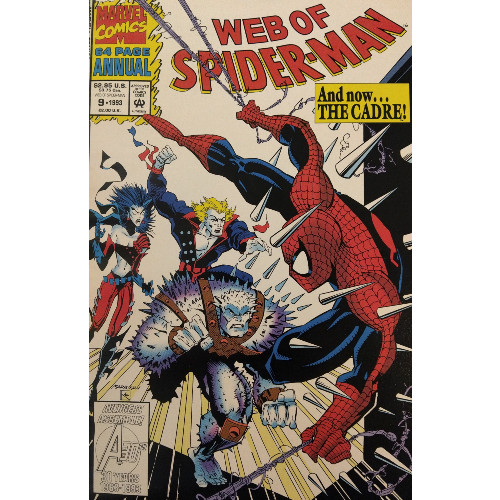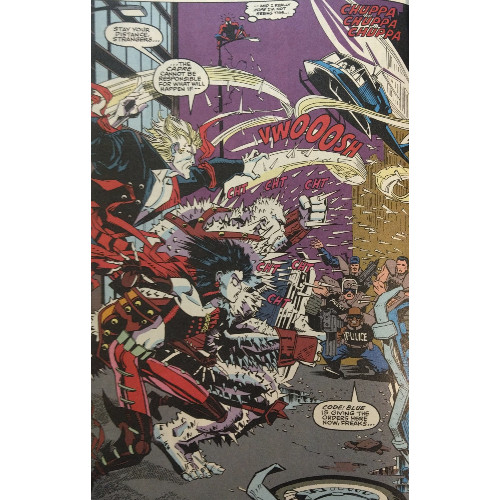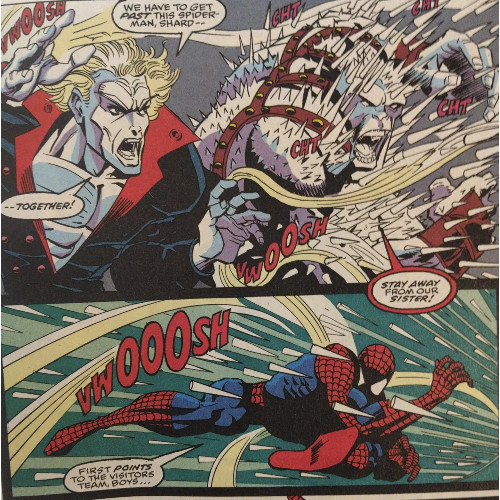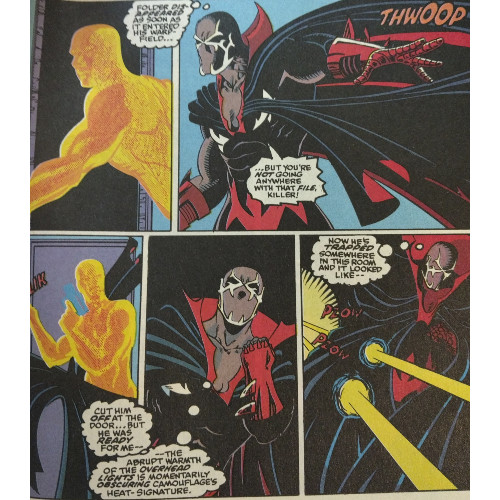Spider-view: "Chaos is the Cadre"
New characters with a promising premise and potential are introduced in a somewhat unbalanced annual
—by Nathan on August 10, 2025—

We are apparently working our way through a Terry Kavanagh trifecta in "Spider-view," because this is the third post in a row where the man has handled writing chores, first working as part of the "round robin" writers on 1993's massive Spidey event, "Maximum Carnage," and then penning a graphic novel where Spidey teamed up with the Punisher and Sabretooth to stop some unfriendly animal experimentation.
But Kavanagh is largely setting aside costumed vigilantes (though, as we'll see, not completely) to tell a somewhat different story for 1993's Web of Spider-Man annual. Instead, he takes a page out of Eric Fein's book, specifically the same year's Amazing Spider-Man annual, by introducing a new group of villains. Where Fein brought about one bad guy in the form of the armored Annex, Kavanagh bumps up the stakes by giving us not one, not two, but three whole new bad guys…who might not even be villains?
Meet the Cadre, a trio of superpowered siblings who I expect were intended to have more staying power than they actually did…kinda like Annex. I say that as a joke, but we really should scope out the narrative itself to see whether potential was wasted or if the group would have been better left on the cutting room floor.
"Chaos is the Cadre"
Writer: Terry Kavanagh
Pencilers: Nelson Ortega, Chris Marrinan, Vince Evans, Fred Haynes, and Mark Powers
Inkers: Don Hudson, Keith Williams, Bill Anderson, Tim Tuohy, and Hector Collazo
Colorists: Marie Javins, Joe Rosas, Mark Bernardo, Dana Moreshead, and Rob Tokar
Letterers: Joe Rosen, Jon Babcock, Rick Parker, and Chris Eliopoulos
Issue: Web of Spider-Man Annual #9
Publication Date: June 1993

The two best aspects about this annual is that Terry Kavanagh writes all the included stories and that the bulk of the issue is dedicated to a singular, overarching narrative told in three parts. Fein's main narrative in ASM Annual #27 was told in 33 pages, longer than a traditional issue, but that left 24 pages to tell two mediocre back-up stories and one fairly decent tale. In WSM Annual #9, 47 pages are dedicated to Kavanagh's main narrative, with only 16 pages telling two ho-hum fill-in stories. Greater space is provided to Kavanagh to tell a more complete story…which he kinda does, with a bit of an exception.
The issue I've taken with these recent Spidey annuals is the interest in debuting new characters and plots writers believe will grab hold of their readers' imaginations. Not that there isn't anything inherently wrong with that concept, and were I reviewing these issues at the time they were released, I might have found more merit in them. But it's been over thirty years since these characters debuted, and aside from appearing in a few other 90s comics, the Cadre has not been seen since. So it's a little difficult to sustain interest in three new characters when you know their impact is limited.

But if we're judging this annual for its merits alone, for the singular story it wants to tell, I feel I need to give more credit to Kavanagh than I did to Fein for ASM #27. Readers are introduced to the Cadre, three superpowered siblings–Vor, Tia, and Ard–who are raised in a monastery from birth and realize they each possess superhuman abilities. Kavanagh notes this is "an age-old story" that "takes a horrific turn for the worst," as the three are abandoned by a mother and taken in and raised, only to discover their abilities and flee their home right before their surrogate family, a bunch of monks in a monastery, are slaughtered.
Yikes.
Most of the narrative deals with the siblings' interactions with Spidey and Code: Blue, a special NYPD division created for the purpose of capturing superhuman criminals. We get a skirmish of pretty decent length in the streets of New York, as our trio battle the cops and our Web-Head in one of those patented "super-people fight over a misunderstanding" type situations. The fun twist in this annual is that, by providing us an origin for the Cadre and outlining their personal predicaments, Kavanagh has developed as much empathy for these characters as he can in the space allowed, thus hopefully dividing readers on what they want the outcome to be. You don't want to necessarily see title hero Spider-Man get trounced by these three, but you recognize that he shouldn't come out the victor standing over their unconscious bodies either…and you certainly want anyone caught in the crossfire when Code: Blue starts firing rounds.

Kavanagh introduces other concepts as well, indicating that there's more of a story surrounding this trio. Digging into it, I found that Kavanagh eventually brought these characters back in Marc Spector: Moon Knight, which he was writing at the time. This means that references to a guy named Seth, the Cadre's parents, and terms such as "dark bloodline," "Hellbent," and "Shadowspawn" may not make a lick of sense to readers not in the know in the issue. I'll admit, despite some brief confusion, I felt mildly compelled to someday read the Cadre's appearances in Moon Knight…not enough to track down the Moon Knight omnibus containing those appearances, but enough to consider reading the remainder of the narrative should it ever find itself reprinted in a more financially viable volume. But I wasn't turned away from the story just because Kavanagh peppers it with enough new terms to make you feel you're reading a fantasy novel where you assume the writer will explain what everything means by the end.
The Cadre are empathetic enough, and I believe the entanglement they find themselves in with Spidey and the cops is handled well narratively and from a illustrative standpoint–artist Chris Marrinan, whose work I appreciated in Ann Nocenti's "Return to the Mad Dog Ward," plays with physical space nicely, as Tia's abilities deal with distortion and illusion. Of the siblings, Tia is the most front-and-center, as her powers lend weight to the central conflict. Vor and Ard have their roles to play and showcase their abilities at times, but Tia provides the impetus for the plot, almost overwhelmingly so. I hoped for a bit more balance between all three characters as they find themselves in the heart of New York, a world so different, if only just culturally, from the monastery where they were raised.

Part of the appreciation for the central narrative I've shared may be in comparison to the two back-up stories, focused on Cloak and Dagger and vigilante Nightwatch, respectively. Nightwatch, as I noted in my "Maximum Carnage" review, really feels like Marvel's answer to Spawn, a dude in a dark costume and a red cape. He does little to set himself apart here, using a good chunk of the 8 pages he's given to recap his origin story before getting into a small dust-up with a villain. There's not much to hold my interest, nor does it make me want to explore the character more deeply. The other 8 pages focus on Cloak and Dagger battling former friend/old foe Mayhem, bringing their rivalry to a seemingly definitive ending. I tend to get a "If you've read one, you've read 'em all" feeling from Cloak and Dagger comics, and all the expected shenanigans happen here as well. If your "Cloak and Dagger" bingo card includes "Cloak pulls someone into his cape" and "Dagger hits somebody with a light dagger," then check off those boxes. My only thought with both of these back-up strips is that Kavanagh has history with all the characters assembled, creating Nightwatch and writing a late 80s/early 90s Cloak and Dagger series and that he wanted to play a little longer in the sandboxes he constructed.
This annual ends up being a fine contribution, straddling the line between "halfway decent" and "fairly entertaining." I've got my gripes about it, sure, but on the whole, Kavanagh directs an interesting story with new characters with promise. As Kavanagh claims, it's an age-old tale with a twist...certainly a dark one, as he indicates, but not without a shred of hope and possibility by the end. It may seem cheap to some folks for me to go "Yeah, as long as you remove the fact these characters appeared in a completely different story in a completely different series after this annual and don't think about this as just a prologue for Terry Kavanagh's later work, it's fine!" That might be a strange angle for me to take, and maybe if I read the Moon Knight issues, I would appreciate this even more, but as a standalone narrative, it's not poorly told…even if it can't quite stand alone. Kavanagh has a little mythology he's cooking up here, and it's interesting to see the seeds planted, even if they sprouted elsewhere.